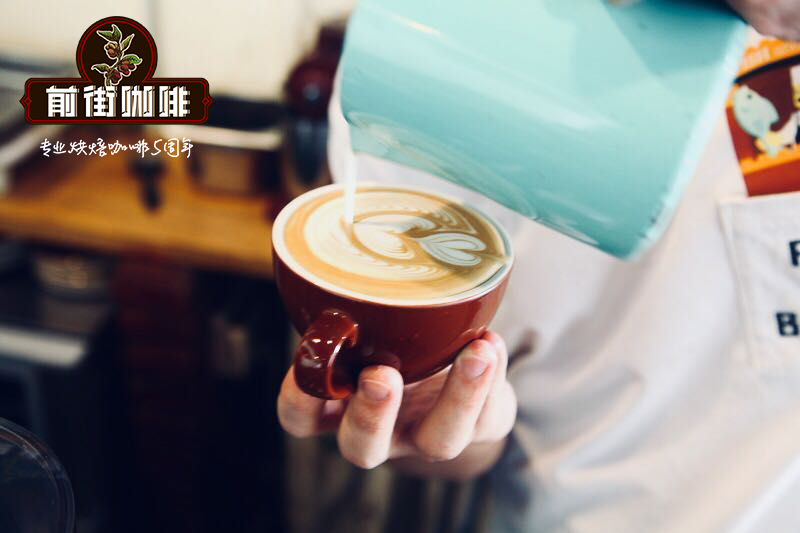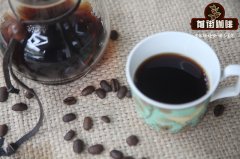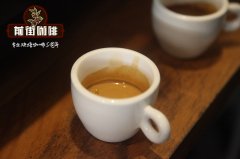Bali Coffee Bean-Bali Coffee Bean

Professional coffee knowledge exchange more coffee bean information please follow the coffee workshop (Wechat official account cafe_style)
Indonesia, the "country of the Thousand Islands", has the largest number of islands in the world. When it comes to Indonesia, the most familiar is probably the resort island of Bali. Today, Xiao Le would like to introduce you to Indonesian coffee.
What is the flavor of Indonesian coffee? Clean + fruity + sweet + spicy! But many people do not agree with the above answer, they think that the traditional Indonesian coffee should be a strong sense of soil, fermentation caused by the stimulation of spicy, and wet wood fiber.
Variety
In Indonesia, 90 per cent of coffee belongs to Robusta, probably as a result of the devastating 19th-century coffee leaf rust. But in the Toraja producing area, 95% of the coffee belongs to Arabica, and the main coffee variety in the Sulawesi Toraja producing area is S795 (also known as Jember), which belongs to the Arabica race, has a strong resistance to leaf rust and has outstanding sweetness (maple male syrup/ brown sugar flavor).
one
Sumatra: Sumatra Coffee
Sumatra is the largest producer of coffee in Indonesia, and the well-known coffee growing areas are mainly concentrated in the northern mountains. The well-known coffees are: Mantenin Mandheling, Lintong Lintong, Mount Gayusan Gayo Mountain.
The name of Mandheling coffee is said to come from the local people, mandailing. The producing areas mostly point to the mountains in the north of Lake dopa, and the specific producing areas need to be verified.
Lintong coffee comes from the foothills around Lake Lake Toba in North Sumatra, Sumatra's largest volcanic lake, and its name comes from the small town called lintong in the southwest of Lake dopa.
Gayo mountain Coffee from Takengon, Takangong, Aceh Province and the mountains around Lake Lake Tawar.
two
Java: Java Coffee
Java is the first region in Indonesia to grow coffee and has taken the lead in the world coffee market as early as the 18th century. The famous Java mocha, made from Java coffee mixed with Yemeni mocha, represents the coffee impression of an era. In addition, there is the classic monsoon coffee Moosooned-coffee, or old coffee Aged Coffee.
Coffee cultivation in Java was originally carried out as a large farm, established by Dutch colonists in the 18th century, and gradually transformed into small farmers after World War II and many changes. High-quality Javanese coffee usually comes from five existing large farms. Although Java coffee production only accounts for about 10% of Indonesia's total coffee production, it is an important component of Indonesian boutique coffee.
three
Sulawesi: Sulawesi Coffee
Sulawesi Island, the most famous is Toraga, or Tonaga, Toraja.
Toraja coffee comes from Tana Toraja in the Tanatolaga region of South Sulawesi, South Sulawesi Province, named after the local population, the Toraga. Tana Toraja is located about 300km north of Makassar, the provincial capital of Wangkasek, and is a famous tourist destination in Indonesia.
At first, the Sulawesi coffee industry mainly supplied the Japanese market.
Deal with
The main treatment method of Indonesian coffee is wet planing, also known as wet shelling (Wet Hulling). This coffee treatment is one of the methods of coffee drying, it makes traditional Indonesian coffee unique, also known as Giling Basah in the local language, is the traditional Indonesian coffee treatment.
one
Why do you use wet planing?
The tradition of using wet planing in Indonesia starts with the local weather. Humidity in Indonesia is between 70 and 90 percent all year round, typhoons continue, and in some areas, annual rainfall can reach as much as 2000mm.
In such a humid climate in Indonesia, dry coffee has become a big problem. Coffee must take longer to dry, during which time the coffee still maintains a high humidity, making it easier for bacteria to soak into the raw beans, and wet planing to remove parchment for the final step of drying, so that the sun shines directly on the surface of the raw beans, causing the coffee beans to dry quickly, 2-3 times faster than washing.
two
Treatment method of wet planing method
Wet planing is a changing form of washing treatment, which can be done by coffee farmers themselves.
"
1. Remove the skin and pulp, and retain the parchment and mucous membrane
two。 Pool fermentation
3. Wash off the mucous membrane
4. Sun-dried parchment for 2-3 days to 20-24% moisture content
5. Scrape off the parchment
6. Dry the raw beans to 12-13% of water content
7. Prepare for exit.
"
Coffee beans mildew slightly during this series of complex drying processes, resulting in the famous "earthy" flavor of Sumatran coffee. This earthy smell of nature is characterized by complex, irritating sweetness and delicacy, as was the case with coffee at Sumatra micro-batch estates at least a decade ago.
With the passage of time, the wet planing treatment of Sumatra has been further improved, and the soil flavor tends to be marginalized and sweet. Some people think of these soil smells as fresh leaves on the ground, tobacco, cedar wood, fir trees, and pepper. Slightly fruity, soft acidity and thick taste.
three
Defect handled: kuku kambing
When the parchment is removed by wet planing, the water content of coffee is still as high as 20-24%, while in general treatment, the water content of coffee is reduced to 10-12% before shelling. In the "semi-dry" state, parchment will adhere to the surface of raw beans, removing parchment is more difficult than "fully dry", and the shelling process requires more friction.
But on the other hand, "semi-dry" raw coffee beans are very fragile at this time, far less hard than "fully dry" raw beans, so beans are more likely to be squeezed and form a small gap. This is what we often call horseshoes or sheep's hoof beans (locally known as kuku kambing).
The super speed of wet planing also causes Manning to have higher defects. Employees will be arranged to carry out manual selection of defects in the processing plant, usually with DP (second hand selection) and TP (third hand selection). After three times of hand selection, Mantenin will be better than the second hand selection in the defect rate.
four
Effect of Wet planing on Coffee Flavor in Toraja area
S795 sweet, black cherry, nutmeg spice (nutmeg), mellow thickness. International Cup critic Mauricio Murillo rated Sulawesi coffee as both fruity and earthy.
Some bakers believe that Toraja is popular in Japan, the United States and some European countries because it can serve as a "bridge" between traditional coffee consumers (inclined to the mellow thickness of coffee) and modern coffee consumers (inclined to coffee flavor especially fruit flavor / cleanliness), taking into account the consumption habits of both.
Local roasters and cup reviewers believe that the boutique coffee flavor outline of Torajan is: sweet nuts, caramel, medium smooth mellow thickness, acidity reminiscent of citrus and passion fruit, spicy similar to cinnamon, cloves, cocoa flavor in the rhyme, coffee overall feel balanced and clean.
Local roasters and cup reviewers believe that the boutique coffee flavor outline of Torajan is: sweet nuts, caramel, medium smooth mellow thickness, acidity reminiscent of citrus and passion fruit, spicy similar to cinnamon, cloves, cocoa flavor in the rhyme, coffee overall feel balanced and clean.
Grading
The grading system of Indonesian coffee can be traced back to the Dutch era, and the latest standard is still based on defect scoring. The coffee quality standard was revised in 1983 and implemented in October 1990, that is, Standar Nasional Indonesia (SNI) biji kopi,No:01-2907-1999.
The washed and dry treated coffee were divided into six grades, G1 to G6, among which G4, G4a and G4bMagi G1 were the highest. That is, G1, G2, G3, G4a, G4b, G5, G6. Usually export beans above G4.
one
General standard for raw coffee beans
1. Water content. The maximum of WP washed beans is 12%, and the maximum of DP of dried beans is 13%.
two。 The content of foreign body. Up to 0.5%.
3. No live insect beans, moldy beans, smelly beans.
4.。 Number of defects in the sample, 300g.
two
Hierarchical reference
three
Reference for counting defects of sun-dried beans
Qianjie coffee: Guangzhou bakery, the store is small but a variety of beans, you can find a variety of unknown beans, but also provide online store services. Https://shop104210103.taobao.com
Important Notice :
前街咖啡 FrontStreet Coffee has moved to new addredd:
FrontStreet Coffee Address: 315,Donghua East Road,GuangZhou
Tel:020 38364473
- Prev

Bali coffee products_Bali coffee which brand is good_Bali coffee beans delicious
Professional coffee knowledge exchange More coffee bean information Please pay attention to coffee workshop (Weixin Official Accounts cafe_style) Bali coffee bean brand introduction: DOMBA sheep gold coffee male beans sheep best-selling coffee flavor rich. Comfortable nutty taste and sweet taste become a favorite of black coffee lovers origin Bali DOMBA sheep gold blend coffee
- Next

Price list of Bali Coffee beans _ Origin of Bali Golden Coffee _ is Bali Bean Coffee good
Professional coffee knowledge exchange more coffee bean information please follow the coffee workshop (Wechat official account cafe_style) Bali coffee bean-public bean is a variety of coffee bean, mainly refers to Peaberry or caracoli, while public bean is just a common name in Chinese. The common bean can be said to be a flaw in botanical theory, which can be caused by two kinds of causes, one of which is that the coffee is treated by Kunming before the fruit is formed.
Related
- Does Rose Summer choose Blue, Green or Red? Detailed explanation of Rose Summer Coffee plots and Classification in Panamanian Jade Manor
- What is the difference between the origin, producing area, processing plant, cooperative and manor of coffee beans?
- How fine does the espresso powder fit? how to grind the espresso?
- Sca coffee roasting degree color card coffee roasting degree 8 roasting color values what do you mean?
- The practice of lattes: how to make lattes at home
- Introduction to Indonesian Fine Coffee beans-- Java Coffee producing area of Indonesian Arabica Coffee
- How much will the flavor of light and medium roasted rose summer be expressed? What baking level is rose summer suitable for?
- Introduction to the characteristics of washing, sun-drying or wet-planing coffee commonly used in Mantenin, Indonesia
- Price characteristics of Arabica Coffee Bean Starbucks introduction to Manning Coffee Bean Taste producing area Variety Manor
- What is the authentic Yega flavor? What are the flavor characteristics of the really excellent Yejasuffi coffee beans?

